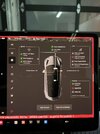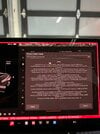Yeah my guess is the modem somehow isn’t pairing with the car.
The modem is a separate board that adapts onto the main AP board. I doubt that there’s any broken traces from the AP board or there would likely be more issues than what I’m experiencing.
I am out of warranty so I was hoping this would be the fix. I have an appointment with Tesla for a general diagnostic on Tuesday. Hopefully someone has some kind of input that would help solve this before then.
Murphy's law says: Anything that can go wrong, will go wrong.
Having shepherded circuit boards through shake & bake testing.. if there's a connector, it can break. Especially after eons of being in a car. Another fun fact: Say that the connector uses tin contacts. Not unusual. When one shoves two tin connectors past each other, the metals make contact; and, tin being tin, they "smoosh" through each other, so, starting from the base, underlying contact material, it goes base->tin->smooshed tin->tin->base.
Tricky bit, though: Tin forms a non-conductive oxide with the oxygen in the air. When one does the initial "smoosh", some oxide bits get broken off and tumbled into the tin. If that happens
once, that's fine; the incidental oxide bits don't materially affect conductivity between the two base metals on either side. And, after that initial "smoosh", if the pin & receptical
don't move with respect to each other, then things are fine. Some good screws holding everything firmly fixed will do the trick for decades. Or if one has a cable with a header on the end, if there's decent, easy flex on the cable and the friction of the connector being plonked onto a circuit board is enough to keep it all fixed in place, then one is good, too.
The problem that can occur is if there's any vibration in all this, where the pin and socket can move back and forth, microscopically. Oxide gets formed when naked tin is exposed to the air; then things move back and forth, more oxide forms, and the oxides and bits of metal start building up in the "smoosh" until, eventually, there's more oxide than metal, the resistance goes up and, ta-da! circuit failure. Especially on low-current, data leads, where there's no heating. (Ever wonder why circuit boards have gold contacts? They don't corrode, and a little vibration doesn't hurt things.)
Still, pulling a board clear out, then plugging it back in again, usually has enough of a wiping action to Help Things Along.
But, there's more! Say there's a header on the circuit board, usually soldered down as part of the IR furnace. So, say one has this circuit board header with, say, 50 contacts or so, all rectangular where they hit the board. And they're all supposed to be coplanar, so, when one hits, they all hit. Solder paste is put on the board; the idea is have enough solder paste to fill in gaps between non-coplanar pins lying on the circuit board, but not so much that, when soldering, the stuff melts and shorts out between adjacent pins.
But.. connectors get dropped. Maybe there's
not quite enough solder paste, or the solder paste "wipe" doesn't work quite right. So, there might be a pin that didn't actually get soldered to the board, but is in incidental contact with the circuit board pad. Fun fact: It might work well enough to escape the factory like that. Then, as time moveth on, oxygen infiltrates the spot where the two metals are lying against each other, taking what should be a low-ohmic connection and slowly making it higher.. until it doesn't work so good no more.
The times I've chased things down this far, I've had full schematics, placements, and have already worked out that Something's Not Right In Denmark. By this stage, I'll have a microscope out and a teeny tiny dental pick poking along. Yeah, I've found lifted pads, cracked plastic bodies of connectors, and other such fun, but that's what it means to be part of the group where The Buck Stops Here

. And if that's not bad enough, then there's loose
zinc dendrites that have broken loose and shorted across things. (By the by: Those things are thin enough that the best optical microscopes can't see them: One needs an electron microscope to do the job.)
But most of the above are outliers. More likely, buffers on integrated circuits may have blown due to random failures (see: FIT rates); if the buffer was on the Big Circuit Board, then fooling with the modem board, while a good idea, isn't going to do the trick.
And sometimes it's something dead stupid: Like, some wire-or-other getting loose and shorting the GPS antenna with the wireless antenna and making both Not Work So Well.
Good luck!




